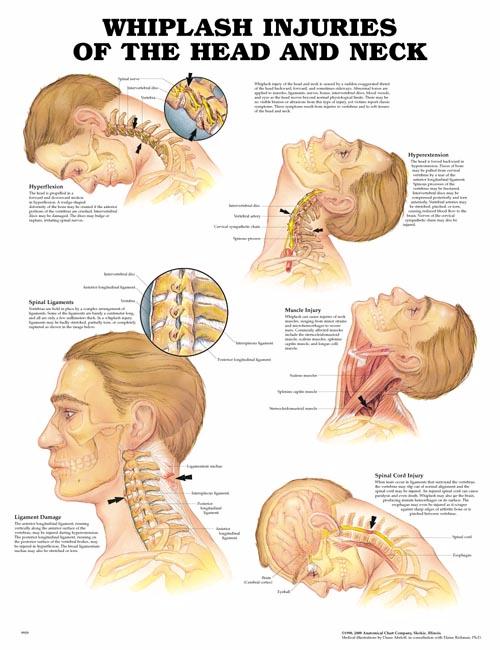Whiplash – how to manage a true pain in the neck

Here at advance physiotherapy and sports injury clinic based in Lisburn Northern Ireland, we treat a number of different injuries and painful conditions. One of the injuries we will often see is whiplash Associated Disorder (the official term – WAD). It’s a condition that has bad press because some people see money signs when their insurance company asks have they been in any pain since the road traffic collision. Answer Yes + then get treatment = more money. But actually for most people it’s not that simple. All cases of whiplash go through a thorough assessment and screening to determine if they have actually suffered from whiplash or if they’re making it up. So if you are thinking of making up a claim: Beware, your physiotherapist will be on to you quickly and suss you out.
This post is really for those who have actually suffered neck related injury from a road traffic collision. It’s for average Joe who is in pain and who actually wants to recover. It’s a simple guide to help you improve your recovery. So here it is, my top tips on managing whiplash.
Three useful tips on how to manage whiplash from a physiotherapist’s viewpoint
- STAY RELAXED – Whiplash can be stressful. You’ve just been hit from behind by another car and you’re stressed thinking about who to call, what damage has been done to the car and remembering to swap details with the other driver. The shock of being hit from a car that you perhaps did not see in the rear mirror can raise stress levels. Driving afterwards can sometimes make you more anxious. Your shoulders start to ache and then you shrug your shoulders from the tension of all that’s happened. Remember “Stay Relaxed!”. Let the shoulders relax and elongate.
- MOVEMENT IS KEY – “Active exercise for pain reduction should start within four days of injury” (Chartered Society of Physiotherapy 2005). I don’t know about you but prior to becoming a physiotherapist the first thing I would have thought was that image of someone wearing a collar for weeks on end not moving the neck at all. For a review of whether a neck collar is appropriate see here. This use to be the way whiplash was always treated. Nowadays one of the key messages is that gentle movement of the neck is so important to a complete recovery and should be started as early as possible (see here for a great resource). Once movement has improved then it’s important to gently strengthen the neck (See the deep neck flexor program for an effective evidence based protocol). For more severe neck injuries where a doctor has diagnosed instability a neck collar may be used but this is on the more rare occasions. For most other types of whiplash, Remember “Movement is Key”.

- GET A DIAGNOSIS – One of the first things that you need to do if you’re suffering with neck pain after a road traffic collision is to seek help from a trained medical professional such as your lcoal Physiotherapist. Getting a diagnosis and treatment can be important as:
- Physiotherapy helps you to fully understand what has happened to you in your road traffic collision
- Physiotherapy helps you to decrease and better manage your pain
- Physiotherapy helps you return to work faster
- Physiotherapy helps you to return to your normal activities of daily living and helps you get back to playing your usual hobbies/ sports
So remember – Stay Relaxed, Movement is Key and Get a Diagnosis. And that’s my top tips for helping you to manage your whiplash associated disorder.
What to do with whiplash?
If you have experienced whiplash recently, are still in pain or unable to do your normal day to day activities then seek professional help. Here at advance physiotherapy and sports injury clinic, whiplash is something we treat all the time and get excellent results in terms of reducing pain and getting people back to work. All our physiotherapists are able to diagnose and treat physiotherapy so feel free to ring us on 02892661435 or contact us via email.
TIM@advancephysio
REFERENCES
2005. Clinical guidelines for the physiotherapy management of Whiplash Associated Disorder.
2007. Guidelines for the management of acute Whiplash-Associated Disorders for health professionals.
2009. Neck pain and Whiplash. Chartered Society of Physiotherapy. http://www.csp.org.uk/your-health/conditions/neck-pain-whiplash
Whiplash Associated Disorders. (2017, September 11). Physiopedia, . Retrieved 16:56, February 26, 2018 from https://www.physio-pedia.com/index.php?title=Whiplash_Associated_Disorders&oldid=178714.
Deep Neck Flexor Stabilisation Protocol. (2017, June 6). Physiopedia, . Retrieved 17:08, February 26, 2018 from https://www.physio-pedia.com/index.php?title=Deep_Neck_Flexor_Stabilisation_Protocol&oldid=172702.
When should a collar be used to treat neck pain? (2008). Curr Rev Musculoskelet Med. 2008 Jun; 1(2): 114–119. https://www.ncbi.nlm.nih.gov/pmc/articles/PMC2684205/


